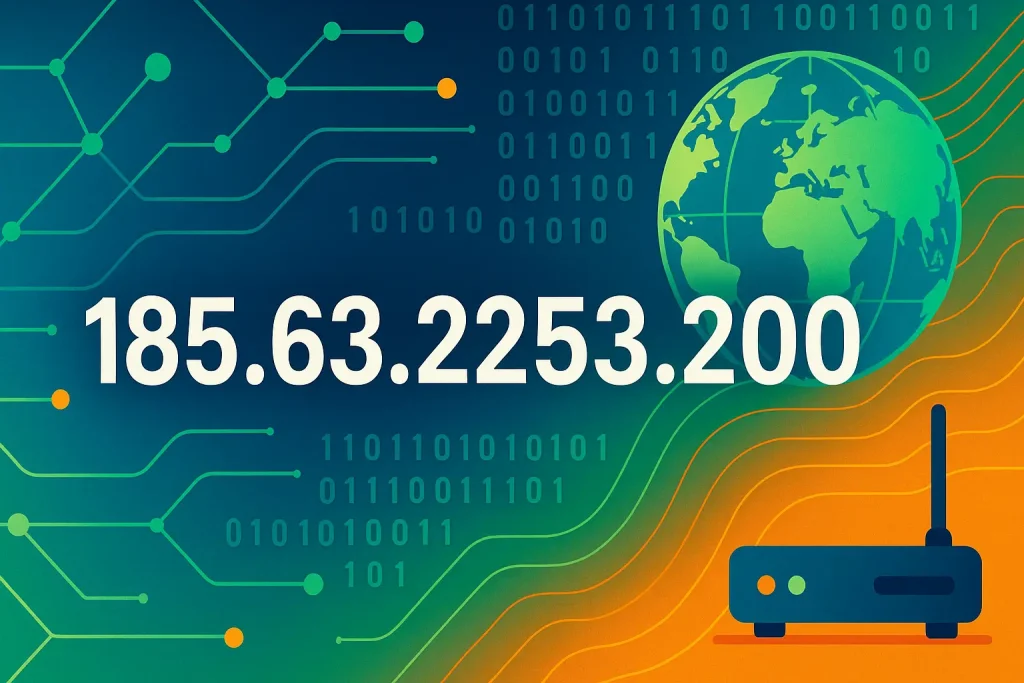
Every second of our digital lives revolves around IP addresses. They’re the foundation of internet communication, connecting devices across the globe. But what happens when an IP address isn’t valid—like 185.63.2253.200? This article offers a fast, authoritative, and trustworthy guide to understanding this common error, what it means, how to fix it, and how to prevent it in future network setups. Whether you’re a tech professional or a curious user, the insights below will empower you to navigate network issues with confidence.
185.63.2253.200 Is Not a Valid IP Address – Here’s Why
The IP address 185.63.2253.200 is syntactically incorrect. IPv4 addresses follow a strict rule: each of the four octets must range from 0 to 255. Here, the third octet, 2253, is out of bounds. This makes the entire address invalid for any form of internet or intranet communication.
This mistake often arises from a typo, software bug, or incorrect IP configuration. It might seem like a minor error, but using an invalid IP can lead to major headaches in network connectivity, configuration, and cybersecurity.
Understanding the Structure of a Valid IPv4 Address
A valid IPv4 address consists of four numbers separated by periods, each ranging from 0 to 255. For example, 192.168.1.1 is a commonly used internal IP. The IPv4 format is essential for routing packets between devices in a network.
This structure allows approximately 4.3 billion unique addresses. The IANA (Internet Assigned Numbers Authority) regulates their distribution. CIDR (Classless Inter-Domain Routing) is used to allocate blocks efficiently.
Also Read: https://fizzymag.co.uk/blackest-person-in-the-world/
Common Mistakes in Typing or Reading IP Addresses
- Typing a number greater than 255
- Using five octets instead of four
- Using commas or dashes instead of periods
- Reversing the order of numbers
- Copy-pasting corrupted or partial IPs
Such mistakes lead to errors in connectivity, troubleshooting, and sometimes, failed software installations.
What to Do If You Encounter an Invalid IP Address
- Double-check each octet to ensure values are between 0 and 255
- Use an IP checker tool to validate the format
- Run ping or traceroute commands to verify connectivity
- Review system logs for incorrect configurations
- Consult your ISP or network admin for assigned IPs
This simple checklist can resolve most IP formatting errors within minutes.
How to Fix or Correct Invalid IPs Like 185.63.2253.200
- Replace invalid octet (2253) with a valid number (e.g., 253)
- Use subnet mask correctly (e.g., 255.255.255.0)
- Reboot router or switch to refresh configurations
- Set static IP manually using proper format
- Let the DHCP assign IPs automatically
These methods ensure that devices can communicate seamlessly across the network.
IPv4 vs IPv6 – What’s the Difference?
IPv4 is based on a 32-bit system and supports 4.3 billion addresses. IPv6, the newer standard, uses a 128-bit format, supporting approximately 340 undecillion unique IPs. IPv6 also includes built-in security features.
The shift from IPv4 to IPv6 is being led by global organizations like IANA and regional registries like ARIN, RIPE, and APNIC. This transition is crucial for the sustainability of internet growth.
Tools to Validate or Check IP Addresses Instantly
Multiple free and professional tools can help:
- IP address lookup sites
- WHOIS lookup services
- Online IP validators
- Network scanner tools like Nmap
- Packet analyzers like Wireshark
These tools help ensure your IP settings are correct and traceable, saving time and improving security.
How Invalid IPs Can Impact Network Configuration
- Blocked device communication
- DHCP assignment failure
- Network traffic rerouting issues
- Increased vulnerability to spoofing
- Firewall misconfigurations
An invalid IP can cascade into broader system failures, especially in enterprise environments.
Cybersecurity Risks Linked to Misconfigured IP Addresses
- Easier target for IP spoofing attacks
- Exposure to internal threats due to misrouting
- Denial-of-service (DoS) vulnerabilities
- Weak firewall/NAT configurations
- Traceability issues during breaches
Security starts with solid IP configuration. One small mistake can open big doors to attackers.
How Hackers May Use IP Spoofing and What to Watch For
- Sending packets with a fake source IP
- Bypassing security rules on routers/firewalls
- Redirecting data to unauthorized servers
- Impersonating trusted devices
- DDoS attacks using spoofed IPs
Always monitor network logs and validate unknown IP traffic with tools like Wireshark and firewalls.
The Role of IP Addresses in Internet Communication
IP addresses act as the street addresses of the internet, identifying senders and receivers. Without IPs, data couldn’t reach its destination.
This communication is facilitated by DNS (Domain Name System), which translates domain names (like google.com) into numerical IP addresses.
Tracing a Valid IP Address: Tools and Techniques
Tools like traceroute, ping, and WHOIS allow users to trace the origin and path of an IP. These are crucial in network diagnostics.
Understanding an IP’s location and ownership can help identify potential threats and resolve latency issues effectively.
IP Address Geolocation: What It Can and Can’t Tell You
IP geolocation can reveal a device’s general region, ISP, and time zone. However, it’s not always accurate to street level.
Law enforcement and cybersecurity professionals often use IP geolocation to track threats, but results should be verified with other data.
Private vs Public IP Addresses Explained Simply
Private IPs (e.g., 192.168.x.x) are used within home or business networks. Public IPs are visible on the internet and assigned by ISPs.
NAT (Network Address Translation) allows multiple private IPs to share a single public IP. This is key for both security and scalability.
How DNS and IP Addresses Work Together Behind the Scenes
- You type a domain name in your browser
- The DNS server checks its record
- It returns the associated IP address
- Your browser uses the IP to fetch the website
- The website responds and displays content
This invisible dance happens in milliseconds and is vital to online browsing.
Common Network Errors Caused by Incorrect IP Entries
- “Destination host unreachable”
- “IP conflict detected”
- “Invalid IP configuration”
- “Unable to connect to server”
- “DNS server not responding”
These errors can usually be resolved by correcting the IP or allowing DHCP to auto-assign a valid one.
Why IP Address Ranges Matter for Routers and Firewalls
Routers and firewalls use IP ranges to allow or block traffic. CIDR helps define these ranges efficiently.
Correct range setup ensures only authorized devices connect, reducing attack surfaces and improving control.
How ISPs Assign and Manage IP Addresses
- Use DHCP to assign dynamic IPs
- Provide static IPs for business needs
- Monitor IP allocation through IANA guidelines
- Rotate IPs to manage scarcity
- Block or blacklist abusive IPs
Your ISP plays a critical role in your network health and visibility online.
Understanding IP Blacklisting and Security Reputation
An IP can be blacklisted if linked to spam, malware, or abusive behavior. This affects email delivery and site accessibility.
Tools like Spamhaus and Barracuda can check if your IP is on a blacklist. Regular monitoring keeps your reputation clean.
Protecting Your Network with Proper IP Configuration
Start with strong IP planning. Assign private ranges properly, use firewalls, and monitor with network tools.
Keep your firmware updated, enable secure DNS, and educate users on IP-related best practices.
Real-World Examples of IP Address Misuse and Consequences
In 2016, a misconfigured IP led to a massive outage for a global airline. Misrouted traffic brought systems to a halt.
In another case, an exposed IP allowed hackers to penetrate a city’s camera network, raising national security concerns.
FAQs
Q: Why is 185.63.2253.200 invalid?
A: The third octet (2253) exceeds the allowed maximum of 255.
Q: How can I check if an IP is valid?
A: Use IP checker tools or online validators. Tools like Nmap or Ping can help too.
Q: What happens if I use an invalid IP?
A: It could cause connection failures, security risks, or configuration issues.
Q: What is the difference between static and dynamic IPs?
A: Static IPs don’t change; dynamic IPs are assigned temporarily by ISPs.
Q: How does DNS interact with IPs?
A: DNS translates domain names to IP addresses so browsers can load websites.
Final Thoughts
IP addresses are the digital lifeblood of communication. One wrong digit—like in 185.63.2253.200—can cause a cascade of problems. But with the right tools, best practices, and a foundational understanding of IP structure, you can protect your network, streamline your connections, and confidently resolve errors.






